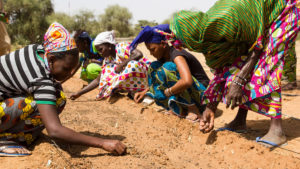The planting of an 8,000km ‘wall’ of trees is underway in Africa. If completed it will be three times the size of the Great Barrier Reef and the world’s largest living structure.
The aim is help fight desertification and land degradation and to restore native plants in the ‘drylands’ of Africa. New fertile areas will provide sustainable livelihoods for local people, particularly in the the worst hit drought-prone areas such as the Sahel region on the edge of the Sahara where poor land management (over farming; over grazing) and a lack of arable land has led to food and water security concerns for the booming population.
The Sahel receive only 4-24 inches of water in a year and climate change is expected to further impact this region. An estimated 500 million people live on land undergoing desertification. If people can’t provide for their families, the practice of ‘transhumance’ (migrating from one area to another with livestock in a seasonal cycle) may become more widespread.
Protecting and restoring
The initial vision for the $8-billion Great Green Wall, a project launched in 2007, was to span Africa from west to east restoring 100 million hectares of degraded land by 2030. This 15km wide buffer of new trees would generate thousands of rural jobs and create a vast carbon sink – it is estimated the trees would absorb c 250 million tons of CO2 from the atmosphere.
This process of using natural resources (as opposed to man-made structures) to ward against the impact of climate change is called ecosystem-based adaption : trees, wetlands, lakes and streams are natural water stores; the foilage of trees can provide deep, cooling shade; mangroves work as coastal defences and the roots of vegetation protect against soil erosion.
However, it’s not simple to plant a forest on the edge of a shifting desert!
Rather than a band of trees stretching the width of the continent, Africa’s Great Green Wall is more a wide belt of vegetation surrounding pockets of farmland along the margins of the Sahara. These ‘shelter belts’ (lines of trees & shrubs) protect areas, including precious crops, from extreme weather events.
The green mosaic varies from country to country depending on traditional farming techniques and the individual goals of any given nation, for example, to diversify crops, slow soil erosion or improve soil fertility.
For example in Senegal local farmers are allocated land parcels and are encouraged to regenerate native vegetation on the land – this includes acacia species Senegalia senegal, which has economic value through the production of gum arabic which is widely used as a food additive. It is their responsibility to dig irrigation canals and plant drought-tolerant species. Results have already been seen and the relationship with the landscape has subtly changed. Lush oases of banana, cassava, okra, lemon, mint and mango have been springing up amidst these natural vegetation shelter belts. Rather than adopting intensive farming techniques and clearing land, children learn to nurture the vegetation that’s already there, creating these green zones and helping to retain ground water and create shade/protection for their crops.
In turn, the vegetation provides habitat for endangered species and helps to safeguard biodiversity.
 15% of the wall is now complete with 21 countries involved. Statistics below from the United Nations Convention to Combat Desertification:
15% of the wall is now complete with 21 countries involved. Statistics below from the United Nations Convention to Combat Desertification:
Ethiopia: 15 million hectares of degraded land restored, land tenure security improved
Senegal: 11.4 million trees planted, 25 000 hectares of degraded land restored
Nigeria: 5 million hectares of degraded land restored and 20 000 jobs created
Sudan: 2,000 hectares of land restored
Burkina Faso, Mali, Niger: about 120 communities involved, a green belt created over more than 2,500 hectares of degraded and drylands, more than two million seeds and seedlings planted from fifty native species of trees
“The Great Green Wall is about development; it’s about sustainable, climate-smart development, at all levels. Each of the 30 countries developed national action plans, That is the biggest achievement, because now they own it. It’s about ownership, and that has been the failure of development aid, because people were never identified with it. But this time they identify. This is our thing.”
– Elvis Paul Tangam
African Union Commissioner for the Sahara and Sahel Great Green Wall Initiative.
For more information visit Great Green Wall.
Images: Great Green Wall


